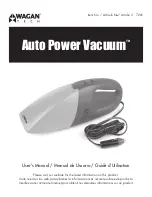
10
PI-198
December 2020
this clearance should be greater. Insufficient side clearance may cause
lance to blow back toward operator.
4. Be sure nozzle, lance and adapter thread sizes are compatible before
installing nozzle and adapter on lance. Do not use a rigid lance that has
damaged or missing threads.
5. Use wrench flats (when available) or a properly adjusted smooth jaw
plier wrench (JS PN 64119) to connect lance. Do not use pipe wrench as
wrench marks will cause high pressure components to crack and fail.
6. A rigid lance over 4 ft long requires two men for support and safe
operation. Operator at tube should use a foot control gun so he can
instantly relieve system pressure in case of emergency.
7. When using and moving lance, support it in a manner to avoid stress
and possible breakage at inlet end connection.
8. Never ”ramrod” lance into tube blockage.
9. Transport and store lances in tubes or racks to avoid bending,
corrosion or other damage. Damaged lances (bends, mars) should be
removed from service.
HIGH PRESSURE FITTINGS
1.
Read General Safety
section prior to installing fittings in system.
2. Use non-brass or non-cast iron fittings which are made for high
pressure waterblast use.
3. Use only high pressure fittings which are clearly marked with the
operating pressure.
4. High pressure fittings should have a known burst rating of not less than
3.0 times system operating pressure. Never use a damaged or corroded
fitting or one with damaged or missing threads.
5. Use only high pressure rated fittings and hose in the waterblast
system. For 10,000 psi waterblast service all fittings and hose should
have a minimum burst rating of 25,000 psi; for 15,000 psi service they
should have a minimum burst rating of 37,500 psi; for 20,000 psi service
they should have a minimum burst rating of 50,000 psi.
6. Use wrench flats (when available) or a properly adjusted smooth jaw
plier wrench (JS PN 64119) to tighten fittings. Avoid using pipe wrench as
wrench marks will cause high pressure fittings to crack and fail.











































